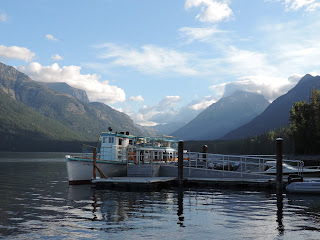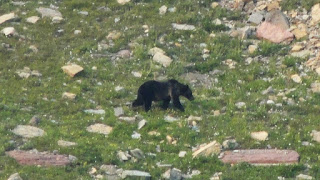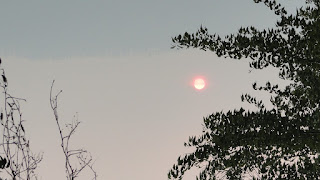This is the boat they use for the Lake McDonald boat cruise. They're loading passengers to take flight.
Lake McDonald Creek that (surprise! surprise!) flows into Lake McDonald.
After leaving Lake McDonald, we decided to stop at Belton Chalet that is located just outside the west entrance to the park. There area group of these buildings in the village of West Glacier that were built by the Great Northern Railway between 1910-1911. The buildings featured a "Swiss Chalet" architectural style that set the style for much of the Great Northern's building program in Glacier. Ultimately, the site included five buildings, including a dining hall and a hotel facility.
Some of the flowers blooming in abundance around the grounds.
Not far into our journey we were blessed beyond belief. Having just passed Lake McDonald I jokingly said to Gary, "Wouldn't it be great if we saw a moose run through the river?" No sooner were the words out of my mouth when we rounded a curve and there were all these people pulled over at the side of the road gazing at a moose on the other side of the river!!! Oh me, oh my! Could I ask for anything more? NO!!
Me, photographing the moose.
More moose!
Photos taken at Logan Pass ...
Below is one of the glacial horns at the Visitor's Center at Logan Pass. A pyramidal peak--sometimes in its most extreme form called a glacial horn--is an angular, sharply pointed peak which results from the cirque erosion due to multiple glaciers diverging from a central point.
It was a bit chilly, thus the jackets
These next photos were taken along the Going to the Sun Road.
Birch trees ... I love the look of Birch trees.
On the east side of the park, by St. Mary Lake, that's where the worst fire was and in the pictures below you will see just a glimpse of the devastation caused by that wildfire. That's St. Mary Lake peeking through the burned brush.
St. Mary Lake is (as you can see below away from the burn area) a beautiful alpine lake. It is the second largest lake in Glacier National Park.
From here we traveled a little north to the Many Glaciers area of the park. We had heard rumors that the bears were out in that area so we wanted to see bears! Unfortunately, there were no bears (so sad) but we did get the3 opportunity to see Swiftcurrent Lake with Mount Wilbur in the background, and boy was it windy!
Check out the wave action at the shoreline.
I videotaped a short segment so you could really get an idea of how windy it was. I'll upload this video to FB because I'm still experiencing problems with my videos uploading.
Don't you love the "squiggliness" of these pine trees?
Another awesome side trip on this trip was to Falls. We didn't even know this was on the route, but quickly took the turn at Two Medicine to get there and we're glad we did because it was a beautiful area.
Here's Gary on the trail. We really enjoyed our stroll through the forest.
And this was our intended destination, Running Eagle Falls.
The falls were not in full flow. I took a picture of a picture that shows what they look like when they're really in full flow.
Some of the beautiful color change in process.
Another Continental Divide crossing added to our lengthy list!
From this point on in our loop drive, we were outside the park property. Our next stop was this memorial. This is the John F. Stevens Memorial Statue. John was an engineer for the Great Northern Railroad. He was charged with finding a suitable route across the Continental Divide. In December 1889 he located and recorded the pass that had been used by native Indians for many centuries.
Exodus 3:15
God, furthermore, said to Moses, “Thus you shall say to the sons of Israel, ‘The LORD, the God of your fathers, the God of Abraham, the God of Isaac, and the God of Jacob, has sent me to you.' This is My name forever, and this is My memorial-name to all generations.















































































